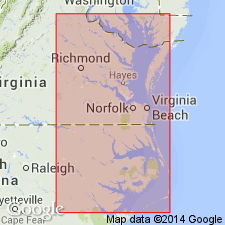
- Usage in publication:
-
- Eastover Formation*
- Modifications:
-
- Named
- Dominant lithology:
-
- Sand
- Clay
- AAPG geologic province:
-
- Atlantic Coast basin
Summary:
Named the Eastover Formation of the Chesapeake Group for Eastover, Surry Co., southeastern VA. Consists of greenish-gray to tan, fine-grained, fossiliferous silty sand, clay, and shelly sand. Thickness ranges from 6 to 24 m. The Eastover can be divided into two members (ascending), the Claremont Manor Member and the Cobham Bay Member. Unit unconformably overlies the St. Marys Formation, or to south, progressively older sediments. It unconformably underlies the Sunken Meadow Member of the Yorktown Formation. The Eastover is of late Miocene (Tortonian) age.
Source: GNU records (USGS DDS-6; Reston GNULEX).

- Usage in publication:
-
- Eastover Formation
- Modifications:
-
- Overview
- AAPG geologic province:
-
- Atlantic Coast basin
Summary:
Chesapeake Group is shown undivided on the State map, but its formations--Chowan River, Yorktown, Eastover, St. Marys, Choptank, and Calvert--are discussed in the text. Eastover Formation is described as dark-gray to bluish gray, muddy sand, very fine to fine, micaceous, interbedded with sandy silt and clay. Lower part of unit is dominantly medium- to very thin-bedded and laminated silt and clay interbedded with very fine sand. Lenticular and wavy bedding is common. Upper part is mainly very fine to fine-grained sand containing abundant clay laminae. Members not discussed. Typical mollusks include CHESAPECTEN MIDDLESEXENSIS, MARVACRASSATELLA SURRYENSIS, and GLOSUS FRATERNA. Thickness is 0 to 270 ft. Age is late Miocene.
Source: GNU records (USGS DDS-6; Reston GNULEX).
For more information, please contact Nancy Stamm, Geologic Names Committee Secretary.
Asterisk (*) indicates published by U.S. Geological Survey authors.
"No current usage" (†) implies that a name has been abandoned or has fallen into disuse. Former usage and, if known, replacement name given in parentheses ( ).
Slash (/) indicates name conflicts with nomenclatural guidelines (CSN, 1933; ACSN, 1961, 1970; NACSN, 1983, 2005, 2021). May be explained within brackets ([ ]).

